|
Limitar tu búsqueda
[+–] Compilador o editor
[+–] Editorial
[+–] Fecha
[+–] Formato
[+–] Idioma
[+–] Tipo de documento
[+–] Tipo de recurso
|

|
|
Introduction (on the subject that is addressed in the issue number)
In this issue of Well-being and Social Policy we have tried to include articles that support the debate around social insurance in health. This is an issue in which simple answers are hardly ever found, and a long term effort is required to understand the idiosyncrasy of each country and the best mix of regulation and financing options. Additionally, the studied cases point out to the need of a...
|
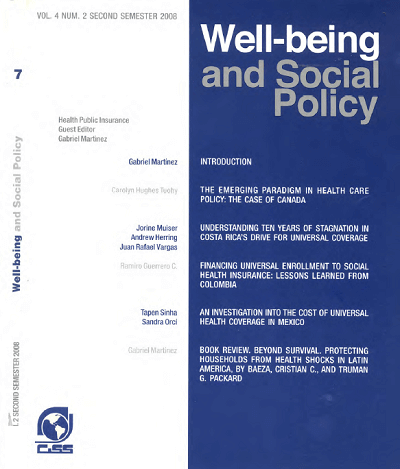
|
|
|
|

|
|
Where did you go to school? Private-public differences in schooling trajectories and their role of earnings
The private provision of educational services has been representing an increasing fraction of the Peruvian schooling system, especially in recent last decades. While there have been many claims about the differences in quality between private and public schools, there is no complete assessment of the different impacts of these two type of providers on the labor markets. This paper is an attempt...
|
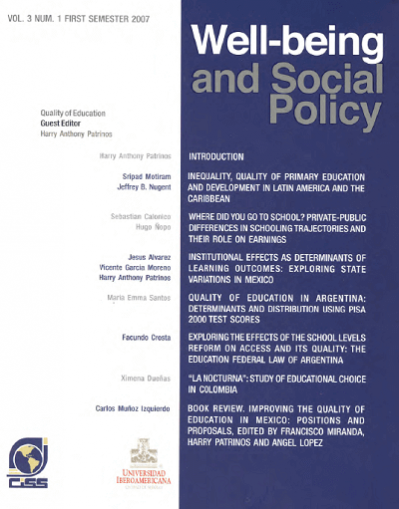
|
|
|
|

|
|
Assessing Argentina's preparedness for the knowledge economy: measuring student knowledge and skills in reading, mathematical and scientific literacy with evidence from PISA 2000
The results of 2000 study of the Programme for International Student Assessment (PISA) show that while Argentinean students performed similar to their peers in most other Latin American countries, they lagged behind all OECD and most of other participating countries. Attention needs to be given to further master the reading, math and science skills that are needed for a knowledge economy; and...
|
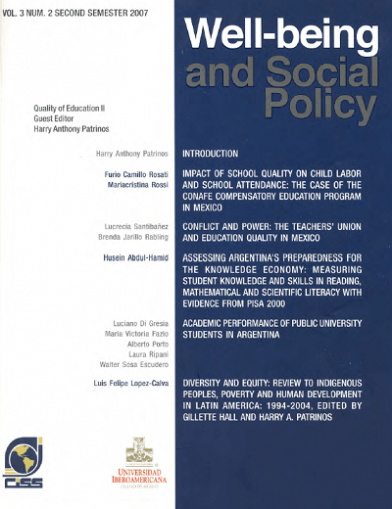
|
|
|
|

|
|
Conflict and power: the teachers' union and education quality in Mexico
The teachers union in Mexico, or Sindicato Nacional de Trabajadores de la Educación (SNTE) represents over 1 million members and is the largest in Latin America. This study uses data from the national student tests administered by the Instituto Nacional para la Evaluación de la Educación (INEE), along with data from the Mexican Ministry of Education and other sources, to investigate the...
|
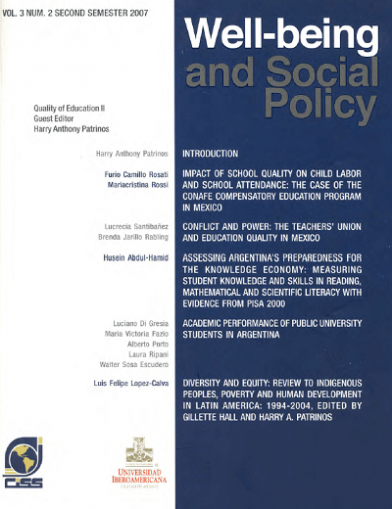
|
|
|
|

|
|
Impact of school quality on child labor and school attendance: the case of the CONAFE compensatory education program in Mexico
This paper focuses on the impact that two different types of policy interventions, namely enhancing school quality and contingent cash transfers, have on child labor and school attendance in Mexico. While there are many studies on the impact of Oportunidades on schooling outcomes, little evidence is available on whether school quality programs such as CONAFE also reduce child labor and help keep...
|

|
|
|
|

|
|
Introduction (about the internatinal conference on "The quality of education in Latin America and the Caribbean")
The Inter-American Conference on Social Security (CISS) and Universidad Iberoamericana (UIA) co-hosted an international conference on "The Quality of Education in Latin America and the Caribbean" in February 2007. The conference examined the quality of education in the region, the determinants of learning, policy and program evaluation, and the impact of quality of education on the labor market....
|
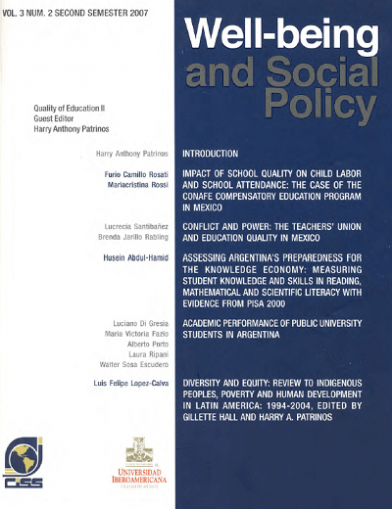
|
|
|
|

|
|
Book review. Improving the quality of education in Mexico: Positions and proposals, edited by Francisco Miranda, Harry Patrinos y Ángel López
This book gathers analyses performed by several authors on policies considered appropriate by the World Bank to enhance the quality of basic education provided in Mexico, in particular, education received by majority sectors in our society (World Bank: 2005).
|

|
|
|
|

|
|
"La Nocturna": study of educational choice in Colombia
This study uses data from Colombia’s 2003 Encuesta de Calidad de Vida to examine how well do electricity strata (proxy for socioeconomic status) explain the choice decision for type of institution and session attended. In the model of choice by type – private vs. public universities – I find that as the electricity strata increases, the marginal probability of enrolling in a public university...
|

|
|
|
|

|
|
Exploring the effects of the school levels reform on access and its quality: the Education Federal Law of Argentina
Over the last decade, Argentina embarked on a broad education reform, the Federal Education Law (LFE), being its main objective to expand access to basic education, mainly, by a new organization of the schooling level structure with the extension of mandatory schooling from 7 to 10 years. The provinces reactions were heterogeneous. We try to evaluate the relationship among the LFE and access and...
|
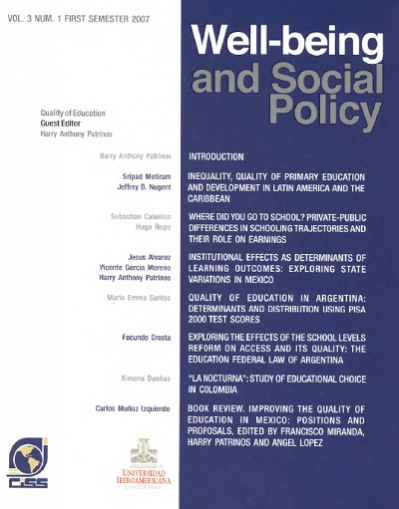
|
|
|
|

|
|
Quality of education in Argentina: determinants and distribution using PISA 2000 test scores
In this paper we study the determinants and distribution of learning outcomes in Argentina I measured by PISA 2000 reading and math test scores. To do that, we estimate education production functions at the mean of the distribution using survey regressions and at different parts of the score 's distribution with quantile regressions. In terms of educational policy aimed at improving learning...
|

|
|
|
|

|
|
Institutional effects as determinants of leaning outcomes: exploring state variations in Mexico
We use the PISA 2003 student-level achievement database for Mexico to estimate state education production functions. Student characteristics, family background, home inputs, resources and institutions are controlled for. We take advantage of the state-level variation and representative sample to analyze the impact of institutional factors such as state accountability systems and the role of...
|

|
|
|
|

|
|
Inequality, quality of primary education and development in Latina America and the Caribbean
This paper draws on a political economy model to hypothesize that the quality of education is likely to be lowered by both economic and political inequalities. In particular, we utilize a panel data set across countries and over time to test the applicability of the hypothesis to quality of education indicators at the primary level. Among the four specific indicators of primary education assigned...
|
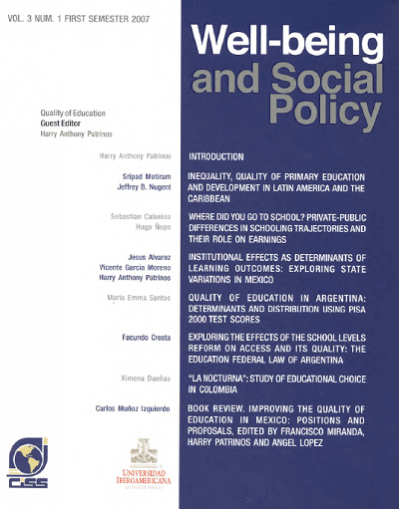
|
|
|
|

|
|
Diversity and equity: Review to indigenous peoples, poverty and human development in Latina America: 1994-2004, edited by Gillete Hall and Harry A. Patrinos
The evolution of specific welfare-related indicators for these indigenous populations during the last decade is the theme of this important book. The study declares to have four guiding questions,
to wit:
1. Have income poverty rates increased or decreased among Indigenous Peoples over the past decade, and what are the main determinants of observed trends?, How does this evolution compare to...
|

|
|
|
|

|
|
Introduction (about the international conference on "The quality of education in Latin America and the Caribbean")
The Inter-American Conference on Social Security (CISS) and Universidad Iberoamericana (UIA) co-hosted an international conference on "The Quality of Education in Latin America and the Caribbean" in February 2007. The main obj ective of the conference was to examine quality of education in the region, the determinants of learning, policy and program evaluation, and the impact of quality of...
|

|
|
|
|

|
|
Review of International migration, remitances, and the brain drain, edited by Çaglar Özden y Maurice Schiff
As the volume title suggests, three of the studies deal with the effects of remittances on incomes and measures of well-being, four address various aspects of highly skilled migration, while the remaining paper examines the determinants of migration from rural Mexico to the US. Each of these is certainly topical: the rise in reported global remittance flows has been a major spur to the recent...
|

|
|
|
|

|
|
The effects of migration on sending countries: a comparison of Mexico and Turkey
International migrants are persons who cross national borders and remain outside their countries of birth or citizenship for 12 months or more, regardless of the reason for being abroad or legal status while abroad. According to UN estimates, the number of international migrants was 191 million in 2005, and half were in the labor force of the destination country. International labor migration...
|

|
|
|
|

|
|
Workers' remittances and currency crises
We seek to further understand the factors that determine per emigrant remittances using data from 23 Latin American and Caribbean countries over the 1980-2003 period. We find that emigrants avoid remitting when the exchange rate is under pressure. This finding is consistent with the notion that remitters strive to reduce their exposure to exchange rate losses by taking into account the expected...
|
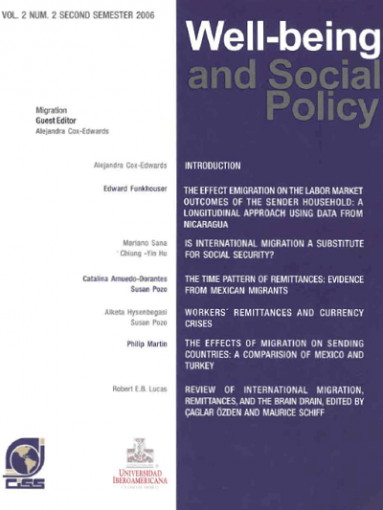
|
|
|
|

|
|
The time pattern of remittances: evidence from mexican migrants
We explore the time pattern of remittances using data on return migrants from the Mexican Migration Project. Some of these return migrants have settled in the U.S. and are returning to Mexico to visit family and friends, whereas others are temporary migrants returning home after a working spell in the U.S. We find that the dollar amount remitted first increases with time spent in the U.S. to...
|
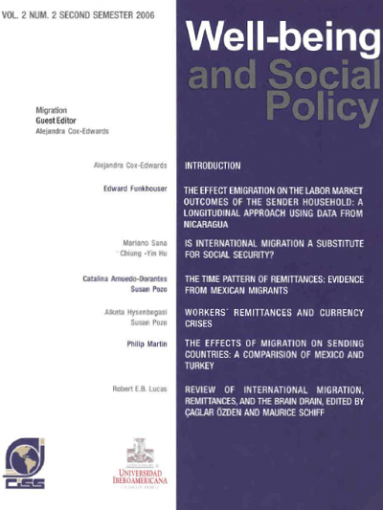
|
|
|
|

|
|
Introduction (about an international conference on "The effects of migration on sending countries")
The Inter-American Conference on Social Security (CISS) and Universidad Iberoamericana (UIA) co-hosted an international conference on “The Effects of Migration on Sending Countries” in February of 2006. The major objective of the conference was to examine a variety of channels through which migration affects the sending countries. Migrants change the dynamic of sending households; alter labor...
|
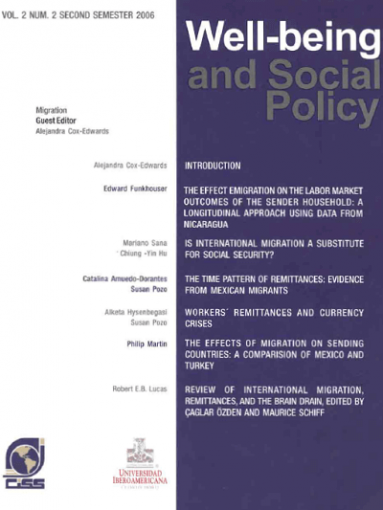
|
|
|
|

|
|
The Americas Social Security Report 2006 The challenges of aging and disability: employment and insurance, and international social security agreements (book review)
The 2006 Issue of the Report on Social Security in the Americas is divided in four chapters. The first two chapters address older-adult issues, the third chapter deals with disability-related problems, and the fourth chapter discusses Social Security agreements in the Americas. In the Presentation, it was pointed out that the objective of the Report on Social Security in the Americas is to become...
|

|
|
|
|
|